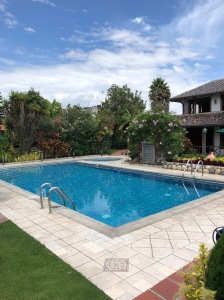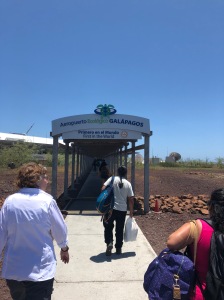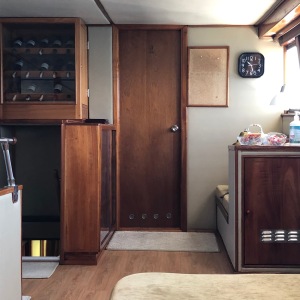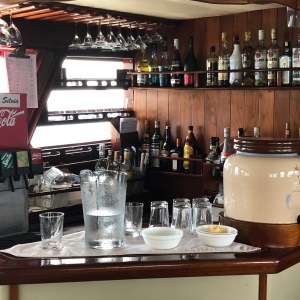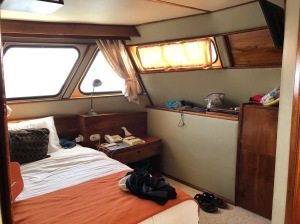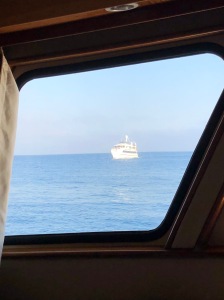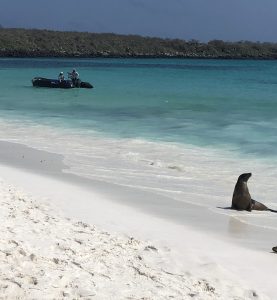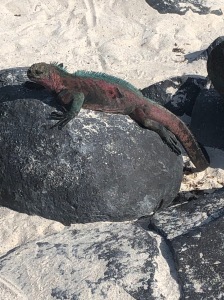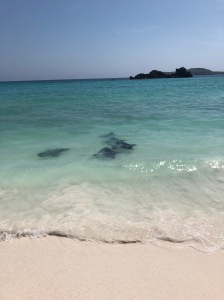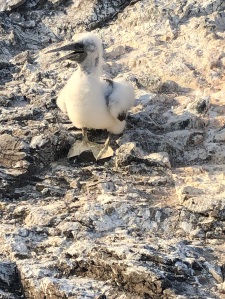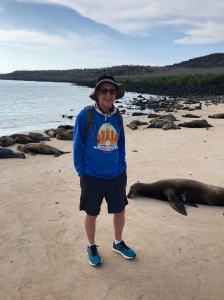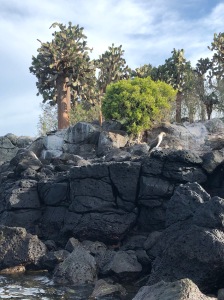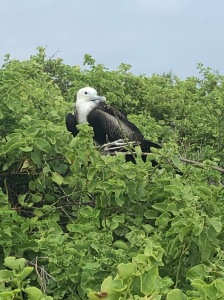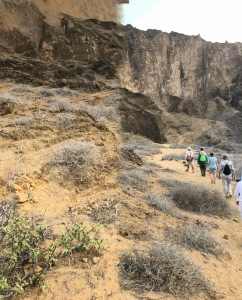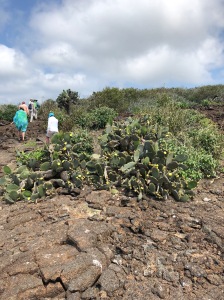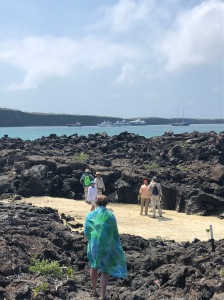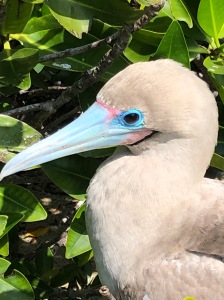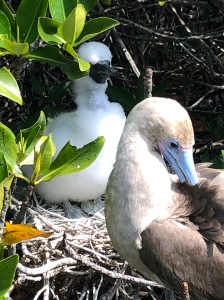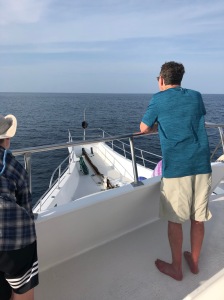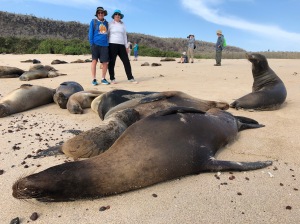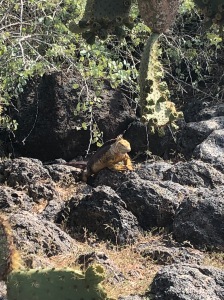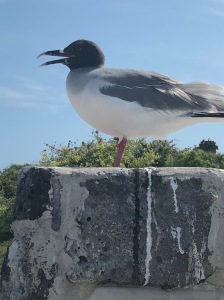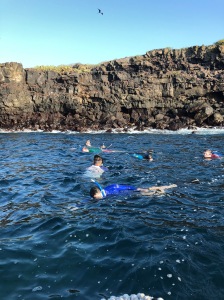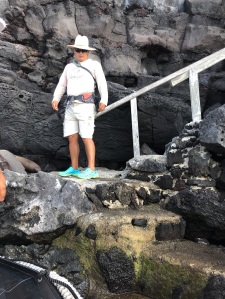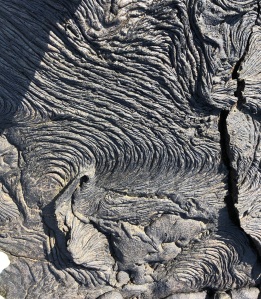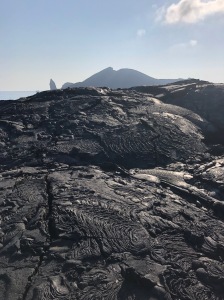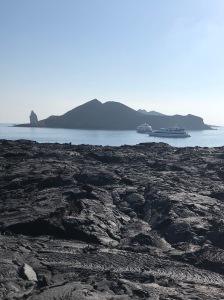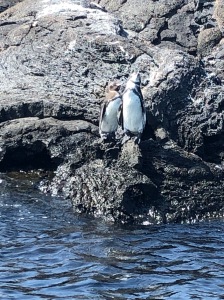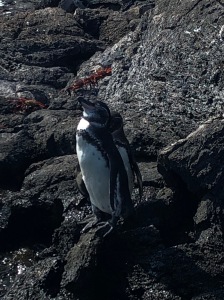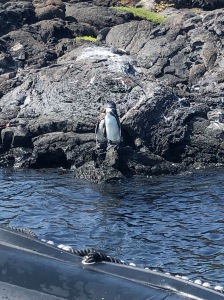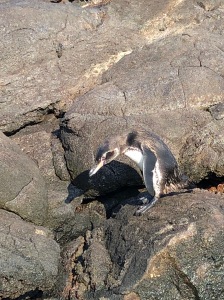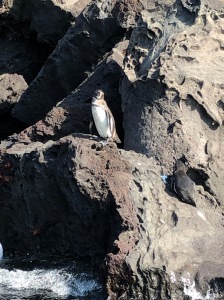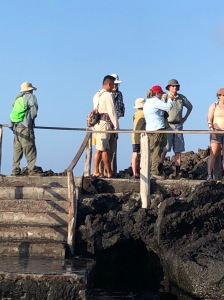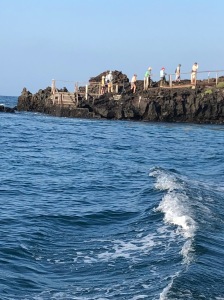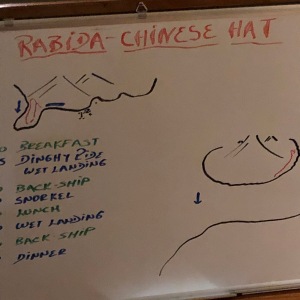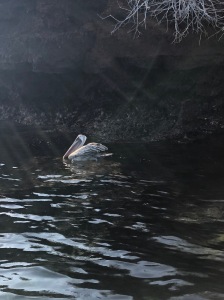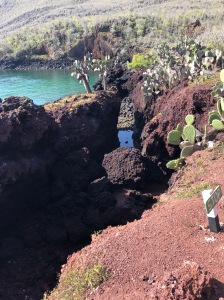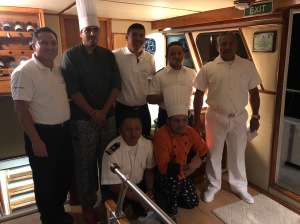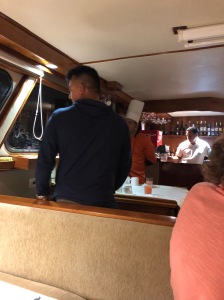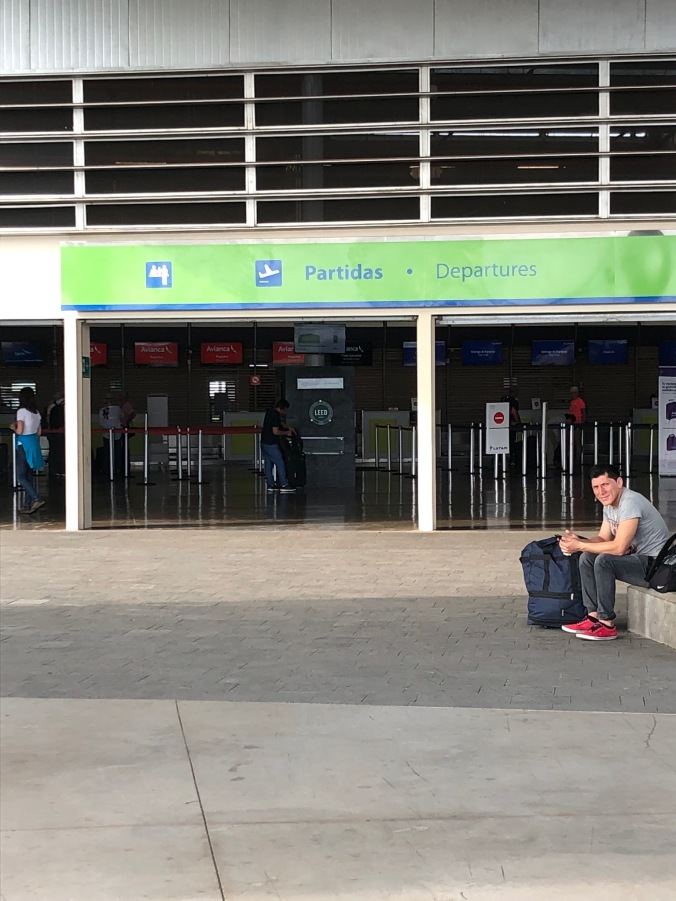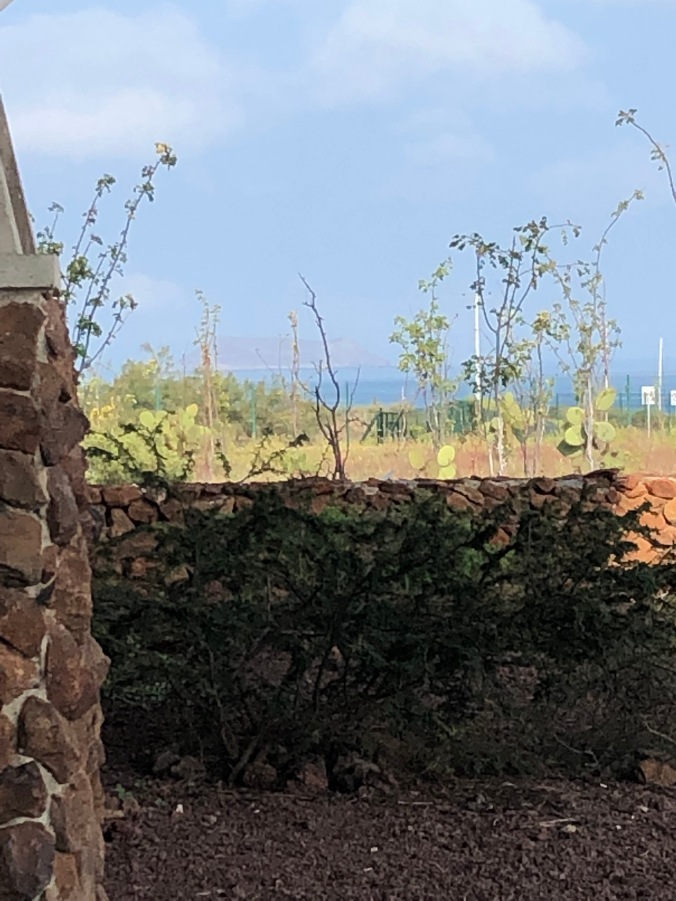Author: jglennox
Cold and relentless
Cold and relentless
Silently stalking across the Serengeti
the moonlight slid over her–
ankle, knee, thigh, groin, belly, ribs, breasts–
to pounce on the throat.
I watched, transfixed:
‘You must not violate the law of the Serengeti,’
the tango of predator and prey.
But everything changes
When the predator is cold and distant
And the prey is lying next to you
smelling familiar.
JGL
She has dreams of Clint Eastwood
‘I always thought I would marry
a rancher’, you said.
Thought or dreamed, I thought.
He would be unlike me in every way.
At dusk he would ride in
tall, straight, hard
covered in dust,
eyes in a permanent squint
boot leather skin
silent.
Rarely
he would simply take you
without ceremony,
as a bull or a stallion would
you smelling of onions or apples
he of dust, fire, sage, himself, horses, saddles.
After, out on the porch, smoking a cheroot,
He would say something
about a broken fence or an injured calf.
And you would feel every inch a woman.
JGL
A Galapagos Slide Show
A Galapagos Video Montage
OUR GALAPAGOS ADVENTURE: A DIARY
MARCH 13, 2019
Not much to say about the beginning of our adventure! That’s good news when you’re traveling by air! Our Delta flight left Pittsburgh for Atlanta on time at noon, after we Uber-ed to the airport with a driver who suffered from loggeria! We were flying first class but on this flight all that really meant was more leg room and comfortable seats. We had a three-hour layover in Atlanta and selected not to use the Delta Sky Lounge. And our flight to Quito also took off on time, and this time first class meant good wine, good food and an unlimited number of first run movies to watch, as well as very comfortable seats. We arrived in Quito as scheduled, and for that story, move on!
MARCH 14, 2019
Our first Day in Quito! We arrived late last night after a long journey (7 hours in planes, 3 in an airport). But a driver from Rincon de Puembo, our hotel in Quito, was waiting for us as we exited customs, and once there they had two delicious fruit drinks waiting for us at check in—and we went straight to bed. The cries of some invisible and noisy tropical bird woke us up ~6:30. We had already decided to just relax around the hotel today, saving sightseeing of Old Town Quito to our final day in Ecuador, since we must be up at 6 a.m. tomorrow to take a flight to Baltra Island in the Galapagos. Great decision! It’s a beautiful day and we are just lounging around the pool (I got a 1km swim in–we’re at 9,000’ altitude in the Andes mountains, so I’m not going to overdo it.) As you can see from the pictures, this is a beautiful place, and the staff are friendly and helpful. The first picture is from the balcony of our “habitácion” the others are of the pool area. Our room is really a suite, very roomy and with a very comfortable bed, and a balcony that overlooks what looks like an street of haciendas, but in fact each is a hotel room. We enjoyed a light lunch by the pool (shrimp ceviche for me, a variety of empanadas for Pat) and then, of course, a siesta! An early dinner and off to the Galapagos early tomorrow morning.
- This way to our room
- The Pool
- …and the Pool!
- View from our Balcony
- Another view from our balcony!
MARCH 15, 2019
We once again were required to rise early, breakfast at 6 a.m., after which we met our cruise travelers for the first time [see above], luggage was loaded onto a shuttle bus that takes us from our hotel in Quito to the Mariscal Sucre Airport for our 9 a.m. flight to Baltra, the small island just a 2-minute ferry ride from the north shore of Santa Cruz Island that serves as the main airport for travelers to the Galapagos Islands. Our floating home for the next 10 days, the Reina Silvia, is already anchored and waiting for us in the harbor of Puerto Ayora, on the southern shore of Santa Cruz. More on that in a moment–for our flight to Baltra did not begin well. The OARS representative did a wonderful job of guiding us through the elaborate customs and security protocol to go to the Galapagos; but as we were about to check our bags, the airline ticket agent said she could not accept our tickets because the passport information in the airline’s system did not agree with the information on our passports! After some rapid-fire Spanish exchanges, Carla, our escort from the hotel to the airport, took us to the ticketing agent for TAME Airways (the primary national airline, and they had to completely rewrite detailed information in the airline website and issue us new tickets, for the cost of $11.20 each and a $20 tip to Carla for handling the situation so professionally…while the other poor 7 people on our adventure waited (patiently or not I do not know, since I was not there). It was frightening, for at the beginning I could see the trip we had planned for almost a year going up in smoke–and worse, being stuck in Ecuador unable to return to Pittsburgh because we had become ‘non (or worse-suspicious) persons’. Once I realized it was not a customs and immigration error but an airlineerror, my only concern was missing our flight, but Carla was very calm and unconcerned, which gave us assurance all would be well.
Here we are with our fellow adventurers: Jerry and Ellen Demers and their daughter Anna; Greg Schuh (Ellen’s brother); and Mickey Yalon, Heather Roney and their son Calvin. At the airport in Quito, awaiting our flight!
And there were more surprises to come–the plane took off on time…and was back on the ground in 45 minutes, way too soon! And as we were landing I was noticing that we were not on an island and we were in the middle of a pretty good-sized city! Now I know the Galapagos is now a bustling tourist attraction, but I had read lots about the airport on Baltra and this clearly was notit! Had we been hijacked? Did we all get on the wrong plane? As we taxied along I could see we were at the airport of Guayaquil, a city south of Quito, on the mainland–we had not been told, but this was a one stop flight! We waited 45 minutes for one group of people to get off the plane and another group to get on, and then we resumed our trip to Baltra! Just prior to landing we experienced something unique to us–to protect the wildlife from invasive pests hitchhiking in on luggage, the flight attendants opened up all of the luggage compartments and sprayed them all with pesticides! Pat noted dryly that they didn’t bother with the backpacks and such stowed under the seats. Similarly, we were not permitted to retrieve or luggage until a security dog had sniffed every piece! But finally, we did arrive!
And eventually, we escaped with our luggage, and as in Quito, our Guide Franklinwas waiting for us–we were transported by van to a ferry boat, ferried across the very narrow strait to the island of Santa Cruz, loaded on another van, and transported–first, to view a series of deep canyons produced by volcanic activity, and then to a Galapagos Tortoise preserve in the highlands of Santa Cruz, where we also were treated to a delicious lunch. This place was Tortoises all the way round! We took an hour long walk and must have seen dozens of the dome-shelled tortoises native to Santa Cruz, of all ages from relatively small (1-2 ft diameter shells) young to huge (4-5 ft. diameter), fully mature ones. We had ample evidence, audio and visual, that it was mating season–and like everything else they do, mating is slow (2-3 hours, preceded by the male slowly pursuing an uninterested and much smaller female) and accompanied by occasional loud moans.
We were then bused to Villa Laguna, our hotel for the night in Puerto Ayora, a port built around the tourist trade as a result of this being the home of the Darwin Research Station and surrounding national park. There is a large yacht harbor where our boat, the Reina Silvia, sat surrounded by many others; and a smaller fishing harbor. The streets are a mish-mash of places catering to the large local population who support this tourist industry and those catering to the tourist trade. We went to the inelegantly named Bahia Mar (“Bay Sea”) for dinner and exhausted, went almost straight to sleep–Franklin was meeting us at 7:20 a.m. for a walk over to the Darwin Research Station, which meant rising at 6 a.m. once more!
MARCH 16, 2019
After our early breakfast at Villa Laguna, we hiked over to the Galapagos National Park and Darwin Research Station, where we saw all of the turtles of different species being bred in captivity to revive endangered populations. This was our only opportunity to see some of the sub-species, other than the Santa Cruz Dome shelled species we saw yesterday, from islands we won’t visit. Pat stopped to by a sarong style wrap, and then we had a very funky lunch at a local spot of empanadas, ceviche and local beer. We then met the group for a short Zodiac across the harbor and a long walk to La Grieta, a grotto filled by an underground connection to the sea. It was surrounded by steep canyon walls where we swam (with dozens of other people, mostly locals doing the same thing). I was able to get a decent amount of swimming in while Pat managed to slip on very hot lava stone scrapping a huge chunk of skin from the bottom of one of her toes (double ouch!). Meanwhile our luggage was transferred from Villa Laguna to the Reina Silvia. After swimming, we hiked back (Pat with a bandaged toe) to the harbor to take the yacht’s zodiac to the boat that would be our home for the next week.
The Reina Silvia is a comfortable luxury cabin cruiser. Our state room, on the main deck, is lovely, with a king bed and full bathroom, just in front of the dining room and bar. There is another state room on the upper deck, but as its residents reminded us occasionally, when there are significant ocean swells you feel the rollin’ and tumblin’ much more up there than on the main deck–and unlike the cabins below deck, we have more room and a nice view! Our guide tells us that when Brad Pitt and Angelina Jolie rented this boat, ours was the room they slept in!
- Door to our main deck state room
- Dining Room
- Calvin reading Harry Potter in the dining room lounge
- The bar
- Our bedroom
- Our king bed
- View of Puerto Ayora from deck
- Our zodiac
- Our bathroom on board
- View from our window
- Saying goodbye to Puerto Ayora
Dinner our first night on board was a delicious locally caught red snapper with stir-fried vegetables and fresh fruit for desert. We all went to bed early and over-night experienced our first open water sailing–lots of rocking and rolling as we sailed from Puerto Ayora to the island of Espanola, the furthest south of the Galapagos Islands. Pat and I are happy to report that we have had absolutely no experience of sea sickness. In fact, I find that the rolling of the ship with the swells is very relaxing–though it does occasionally make walking to the bathroom a challenge!
- Reina Silvia and her partner ship Integrity
- On our way to the next island
- Sunrise in the Galapagos
- Enjoying the breeze
MARCH 17, 2019
We awoke to a slightly foggy morning but by the time we boarded our Zodiac to head to the beautiful white sand beach of Gardiner Bay on the Island of Espanola, which is home to a very friendly population of Galapagos sea lions. We also were treated to a number of incidents of mating behavior by Spotted Eagle Rays, who like to “do it” close to shore. This behavior typically involves 4 or 5 rays at a time, multiple males quite literally competing to couple with one female. Pat and I also walked down the beach to a lava rock outcrop where we encountered a Marine Iguana who was as curious about us as we were about him. And many of our group had taken our snorkeling equipment with us to the beach, and practiced our snorkeling, something Pat and I hadn’t done for more than a decade. Happily, it is like riding a bike…once you’ve learned you don’t forget it.
- Gardiner Bay Sea Lions
- Gardiner Bay
- Pat with a Marine Iguana
- Marine Iguana
- Marine Iguana
- Marina Iguana
- Spotted Eagle Rays
- Spotted Eagle Rays
- Gardiner Bay Sea Lions
We then Zodiac’ed back to the Reina Silvia, changed into our snorkeling clothes, and took a short Zodiac ride to a coral reef system off a cliff just a hundred yards or so from where we were anchored. The snorkeling was amazing–there were young sea lions who enjoyed swimming and diving with us as much as we enjoyed them; and dozens of different kinds of reef dwelling fish of every color imaginable. We had seen a black tip shark swimming along the beach earlier, but we had no shark encounters during our 45 minutes of diving. Reluctantly we returned to the boat for a beautiful roast chicken and vegetable lunch, and a ‘mandatory siesta’, during which the boat sailed to Point Suarez on the other end of Espanola, where we did an arduous 2-mile hike through lava rock of random shapes and sizes (Pat with her taped up toe, recall), visiting our first colony of Galapagos FurSea Lions, multiple varieties of marine iguanas in reds, oranges, turquoises and black, and many varieties of lava lizards and friendly Galapagos mocking birds. We end up at a cliff where there were a number of colonies of “masked” Nazca Boobies. Franklin, our guide, had hoped the Albatrosses would have returned for the season, but they had not. We slowly made our way on a loop trail back to the shore line, and headed back to the boat. After a refreshing shower to clean up, most of the group sat around the lounge on the upper deck and talked and drank some beer, and then went down to a wonderful dinner of fresh prawns with a sort of mashed potatoes/peas blend, and a dessert of strawberries in some sort of liquor based sauce. The food is too much…in both senses of that expression! At both lunch and dinner we are given full three course meals, and though breakfast is buffet-style so that in theory one could abstain, the fruit, eggs, pancakes, French toast, bacon, proscuito, cheese, etc all look so good it would take the will power of St. Francis to do so. But we are getting an amazing amount of exercise, so perhaps too much only in one sense! The scale when we get home will tell! [addendum March 25–too much in both senses]
- Fur sea lions everywhere!
- Landing at Cape Suarez
- Nazca Boobies
- And their baby
- They are unimpressed
- Tree Like Cacti
- Lava Lizards everywhere
MARCH 18, 2019
Overnight we sailed to San Cristobal Island. After another delicious breakfast, at 8 a.m. we boarded the Zodiac for a small Islet off the coast called Isla Lobos (sea lions in Spanish are known as sea wolves), where both the blue footed boobies and the Magnificent frigate birds (there are two species…Magnificent and Great!) were in the midst of their very elaborate courting rituals. While landing we also saw a beautiful sea turtle, at first resting on the sand underwater and then slowly swimming away while we hovered next to it. The trek was mostly difficult, technical walking over piled up lava rocks oriented at all angles and of all sizes; very slow, but given the proximity to all these wild mating rituals, definitely worth it! The boobies stand very close together and the male shows off his blue, webbed feet by exaggerated high stepping and extending a long tail feather behind it, all the while making a high-pitched shriek. The female, on the other hand, begins by feigning no interest. The male tries to attract her as well by showing off a great nesting site; eventually they begin to click beaks, rub necks and become true mates, and head to the nest.
The frigate birds vary greatly by sex and age. The male, during mating season, has the famous red gular pouch puffed out to 5-10 times the size of its head, and makes a warbling call, both of which are intended to attract one of the many white breasted females circling above trying to decide on the best mate. The young are almost as large but have white heads, sometimes mottled with light brown. All in all, we had quite a show! After returning to our landing site we were whisked back to the boat, where we had ½ hour to prepare for more snorkeling with sea lions and an amazing plethora of reef dwelling fish, of every color of the rainbow! Thanks to our field guide, I have most of them catalogued, but we have seen a number of species not in our field guide. This group of sea lions was even more fun and playful that those yesterday, literally swimming constant circles around us–they especially loved it when you would dive and have them chase you around along the bottom. One guy like to glide straight at my mask and at the very last second veer off. I’ve seldom had more fun!
- Yes, they DO have blue feet
- While the male frigate birds are shameless exhibitionists
- Though the white headed young are more restrained
- And their mating ritual is charming
- Point Break!
- Did I mention that the feet are blue?
- “I own this trail”
- Read to play with sea lions!
- A favorite place to relax
We then returned to the boat to sail to so-called “Kicker Rocks”, an amazing out crop jutting up from the sea bed which at some point had split in two, so that there was a beautiful channel between the two parts–a very popular site for experienced scuba divers, and we saw a half dozen small boats there for just that purpose. At about 12:30 we were served an incredible meal of sesame encrusted tuna steaks on a bed of al dente vegetables with a sesame/soy sauce and side of rice, finished with a caramel flan desert. The food on this boat is as good as a 1-star Michelin restaurant! It is now Siesta time–at 3:30 we will have sailed down to Punta Pitt at the other end of the island for another hike. I’m delighted to hear that tomorrow will be our first kayaking day! YES!
- Kicker Rocks
- A typical lunch!
- Enjoying the breeze
- Arrivals and Departures
We did an amazing hike this late afternoon, starting at a beautiful sand beach at the base of a long extinct volcano. The only new fauna we encountered was our first red footedboobies, which are unique in all the world because though they have webbed feet and are excellent divers and swimmers, they perch and nest in treesand have the ability to wrap their webbed toes around branches. They too were mating and have their own strange rituals. We also saw new born blue-footed boobies, and a number of parents incubating eggs. Franklin was very happy to see how many were breeding on this island because in recent years their numbers have been dropping. But the main excitement for me of this hike was that we were wending our way up the walls on the inside of this huge volcano. It was a technical scramble, but much easier than walking on piles of lava rock, and much more like hikes in the California and Utah canyons that I’ve done many, many times. Pat found this much, much easier on her knees that the flat hikes we done on lava stones–and her toe is gradually healing up.
Now we are back on the Reina Silvia and on our way to our next island(s) Santa Fe and Plazas, just off the east coast of Santa Cruz. Dinner is a filet of beef raised on Santa Cruz, and is much less tender that what we are used to in the USA, although very tasty, served with asparagus and potatoes; with a lovely mixture of fruits for dessert.
- Hiking into the Caldera
- at the top, more or less
- A view of the bay
- Red Footed Boobie
- Who Perches with webbed feet!
- Galapagos Stand Up: How do you tell a red footed boobie from a blue footed bobbie?
- The Red Footed Boobie has a Blue Beak!
- One of a number of herons endemic to the Galapagos.
- Onward Ho!
MARCH 19, 2019.
Overnight, there was a steady, heavy swell that kept the boat rolling–it didn’t bother us, but some people came to breakfast feeling a bit sea sick and groggy. After breakfast we boarded the Zodiac for a ride into a small, protected bay on Santa Fe Island, a ‘wet’ landing (i.e. we step out into water) on a small, crescent beach covered with fur sea lions, many sleeping. The bay was mostly sand bottom and the water was a stunning turquoise/aquamarine blue. A white tipped shark was cruising the shoreline looking for sea lion pups, but fortunately didn’t find any. After a few minutes watching the pups frolic, we put on our shoes and started inland. This is our first encounter with the muted orange-colored land iguana–in this case a sub-species unique to Santa Fe, Conolophus pallidus. (Later in the day, when we sail to Plazas, we should see C. subcristatus and perhaps the rare hybrid cross of the land and marine iguanas, which are likely sterile hybrids. We saw a number of the Santa Fe Iguanas on this hike through an arid landscape of trees with few leaves and lots of giant prickly pear cacti (Oppuntia echios). In some parts of this small island there are literally forests of these cacti, growing to 25’ in height with ‘trunks’ over a foot in diameter. On one occasion, a relatively small iguana strayed into the territory of a much larger, older one to eat some leaves, but was immediately charged and chased off. The last part of the trail was along a cliff that gave us incredible views of the Reina Silvia anchored just outside the bay.
- Our new furry friends
- Fur sea lions everywhere!
- Tree Like Cacti
- Land Iguana
- Beautiful golden land Iguana
- Perhaps dreaming of being a Marine Iguana?
- Swallow-tail Gull–hunts at night, and the red ring around the eye helps!
We returned to the boat and had about a 45-minute break before the group jumped into four tandem kayaks to do a relatively quick kayak around the bay (accompanied for much of it by playful sea lion pups swimming along with us). Then, after a 30-minute rest, we donned our swimming gear, grabbed our snorkels, masks and fins, jumped into the Zodiac and were taken to a nearby bay with coral reefs where we snorkeled for about a half hour–and where we saw basically the same amazing rainbow mix of coral reef fish that we had seen two days earlier at Gardiner Bay. We returned again to our boat for lunch, in this case we could select from octopus ceviche, tender chicken legs, an avocado, yellow bell pepper and tomato salad, a tray of raw vegetables, fried plantains, rice, and a fruit cup for desert–as we ate, the Reina Silvia was making its way north up the coast of Santa Cruz Island to Plazas, for another hike. ‘What doesn’t kill you makes you stronger.’ (Corollary: What does kill you, kills you.)
- A View of the Reina Silvia
- Kayaking the Bay
- Beautiful golden land Iguana
Plaza is, as its name suggests, very flat on the shoreline where we landed, and our hike wound gradually up and across the island to the other side, which faces east on the open pacific and is nothing but steep, heavily eroded volcanic cliffs. The crashing waves and consequent swirling eddies of turquoise and white were magnificent. On these cliffs Galapagos petrals were flying around in the 100s finding mates to nest on the cliffs, and there were some blue footed boobies, frigate birds, and some red-billed tropic birds with their extremely long white tail feathers nesting in the crevices of these cliffs. It was an amazing display of bird life! But one sighting in particular moved Franklin especially: sitting on a rock on the edge of the cliff was a Galapagos Hawk! Like all birds here he was utterly unafraid of humans and allowed me to walk right up to him to take his picture! Franklin said he had not see one on this island for more than 20 years, and it was a very good sign. There were also a few very old sea lions who had staked out lonely and quiet ‘retirement’ locales, far from the noisy colony on the other side of the island, to live out their final days. Not a bad way to go.
- Franklin on the Cliffs
- Galapagos Hawk
- Posing for photos
We Zodiac’ed back to the Reina Silvia, and while having a cool beer got word that dolphins could be viewed jumping from the front of the boat and indeed they could! At 6:30 we gathered for a dinner of turkey served kebob style with a mashed pea puree and al dente vegetables, followed by a scoop of Neopolitan ice cream on a small slice of caramel cake! Once more, a lovely meal. The evening was spent in animated conversation with Jerry, Ellen and Anna Demers, partly about our ancestors coming to America, partly about Anna’s upcoming wedding!
Franklin has challenged us to a 7 a.m., pre-breakfast snorkel (“Maybe so early we can see the hammerhead sharks!”) in the now-sea-filled caldera of the island of Genovesa, to which we are currently on route. Pat may sleep in, but I cannot resist. At around 10 p.m. tonight we will cross the equator and be in the northern hemisphere for the first time in a week!
MARCH 20, 2019.
We are anchored in the caldera on the far northern island of Genovesa, an extinct volcano one side of which long ago eroded to the point where the sea found its way in. It is now 6:30, and we are about to get together for our 7 a.m. snorkel in this caldera. Pat did not sleep in, and will come along to photograph and video the snorkeling rather than participate. More later!
Franklin’s great hope for our early morning snorkel was that we would see a hammerhead shark. Well, his, and our, dreams were more than fulfilled–only 10 minutes into our swim we encountered a school of perhaps a dozen hammerheads, ranging in size from 5 ft. to at least 10 ft. We were able to swim with them for ~ 20 minutes; the largest in the group was seriously battled scared, with one fresh wound where a good 8” of flesh had been taken off his right side. This was incredibly exciting–Franklin said he had encountered hammerheads there about 60% of the time; but it was very rare to meet up with a large school of them as we did. One fun aside: a sea lion joined us for our snorkel, but when he saw the hammerheads he began ‘playing’ with them rather than us–they are no threat to him, since they have small mouths and are not nearly as fast or agile in the water.
- Ready for an early dive!
- And ready…
- And diving with hammerheads!
- And sea lions!
Reluctantly we headed back for breakfast–fresh fruit, scrambled eggs, hash browns, bacon, ham, toast, mango juice and coffee. Especially tasted after a half hour chasing sharks around a bay in the Pacific Ocean! After breakfast, we took the Zodiac into a beach at the mid-point of the coast line for our morning hike on Genovesa. From the beach we hiked past a large and densely populated frigate bird nesting and mating site. There were probably 20-30 males with their bright crimson gular pouches fully inflated, and the sky filled with other males and females still searching for the perfect mate. But there were also many pairs who had already coupled and were now busy building nests. In addition, in the bushes, for the most part, were red-footed boobies, mostly already paired off, some caring for eggs and many with young, down-covered chicks of various ages already hatched. These were mostly in and around bushe at beach level; from there we hiked up to a low cliff with a beautiful view of the whole caldera and our boat, along with four others, anchored in the bay. Franklin had arranged time for us to swim and snorkel on the beach–the crew brought our snorkeling gear in to us.
- Boobies, boobies…
- Who Perches with webbed feet!
- Father and son…
We returned to the boat, but only for a scant 10 minutes, and then immediately jumped into kayaks for a paddle along the eastern rim of the caldera and back. This kayak was not very interesting–the coastline had no bays or inlets, and was basically just low volcanic cliffs–not even any sea lions swimming along. And the kayaks leave something to be desired: they are tandems (that’s fine), sit on top (not so fine), with seat backs that are made of cloth and provide no support at all. No doubt we are a bit spoiled by our very comfortable Eddylines at home, but this kayak paddle was one of the few adventures I could have done without.
However, we were revived by a lunch of vegetable soup, an entrée of shrimp, quinoa, beans and cauliflower, and a leche cake for dessert. Currently it is our “mandatory siesta time”–we are scheduled for our second hike, up steep stairs (which we kayaked past in the morning) that are carved into the eastern cliff of the caldera, and then an easy hike along the cliff. The one new species we may see is the short eared owl that is endemic to the Galapagos. So far Franklin has scored 100% in his promises, so we are hopeful!
But, alas, no short-eared owls. We climbed the sta
irs and almost immediately as we started our hike we encountered a violent territorial battle between two male Nazca Boobies, using there long, powerful beaks to grab each others’ necks, wings and legs, and occasionally actually locking beaks with each other. It was hard to watch. A little further on we encountered a rare Gold crowned Night Heron, on our way to the lava fields where the owls blend in so well that there may have been one there that we just missed–although Franklin’s eyes for spotting wildlife on these islands are truly phenomenal. The amazing camouflage of these owls allows them to catch their primary prey, the small petrels, lizards, and mice found on this island.
- at the top, more or less
- Red Footed Boobie
- Yellow-Crowned Night Heron
- A view of the bay
- One of a number of herons endemic to the Galapagos.
When we returned to the boat the staff had prepared a wonderful selection of hor d’ouvres and Manuel poured us champagne to go with them–and as we sipped our champagne, a beautiful full moon rose over the ocean behind us as the Reina Silvia pulled away from the Genovesa caldera. It was certainly a day we will never forget. Dinner–chicken breast, cucumber and tomato salad, and mashed potatoes, followed by a banana split dessert–was lovely, but seemed anti-climatic after the day we’d had.
MARCH 21, 2019.
Overnight we sailed to Isla Santiago (Darwin’s James Island) and anchored between Sullivan Bay and the strikingly rugged island of Bartolomé, with Pinnacle Rock at one end, jutting into the sky at a sharp angle–a sort of natural leaning tower. Here the hope, soon to be fulfilled, was of seeing, and perhaps even swimming with, our first Galapagos Penguins. Our first post-breakfast adventure was a hike across a nearly barren lava field, laid down by an eruption in 1898. Charles Darwin spent considerable time on this island and discussed a salt lake where he met Spaniards encamped to catch turtles and fish and salt them to take back to their ship. Franklin explained that Darwin had come ashore on the north end of the island (we are on the south east) which is where the salt lake is.
There were many fascinating features of this lava field–the flow alternated between what looked like braided rope and pleated folds of cloth, with all sort of fissures, sink holes, and spots that looked like lava had cooled to solidity in the midst of bubbling. There were little hills of tuffa all over, larger volcanic cones in the near distance, and almost no life, either animal or vegetable, other than small bits of ground cover beginning to get a foothold and two or three lava cacti. Before returning to the boat we took the Zodiac along shore because a Galapagos penguin had been spotted swimming near us; we never saw one on that occasion, but did watch a lava heron tracking along the shore line eating crustaceans as he went. I got a wonderful video of it flying along next to us.
- Our Day in Outline
- Franklin taking photos
- Heather, Mickey and Calvin
- Jerry and Greg, with Franklin
- Endless lava flows
- But life finds a way
- Braided Lava
- Calvin going with the Flow!
- Pinnacle Rock
- Pinnacle Rock and the Reina Silvia
We returned to the boat and after a short rest we all elected to snorkel from the Reina Silvia into shore and swim along the reefs. While swimming in to shore, a Spotted Eagle Ray floated gracefully below me, and almost as soon as I began swimming along shore a white tipped shark, about 5 ft. in length, began swimming along next to me between me and the shore line. We swam along shore together for perhaps 50 yards or so, and then I lost sight of him. The group was quite dispersed and it seems I was the only one that got close enough to see this guy, though the people keeping an eye on us from the Zodiac saw him a number of times. There was a beautiful collection of reef fish (Bacalao, Parrot Fish, Grunts, Chubbs, Wrasses of all sorts, Trigger Fish, Angel Fish, Surgeon Fish, Puffers, Damsel Fish and many more) but very few we hadn’t seen on previous dives. And, finally, on our way back, we were able to motor right up to two penguins who had just emerged from the water and were standing on the rocks shaking water out of their feathers. Since I was snorkeling I didn’t have a camera to capture them ‘electronically’, but Micky had his GoPro and so hopefully has some video footage to share with us. And as it turned out, this was not to be our last encounter with the diminutive Galapagos penguins!
We lunched on a sort of Peruvian corn soup, snapper with cauliflower and a sweet potato that was a dark purple in color (probably also Peruvian!), and carrot cake for dessert. After our siesta, a small group of us (Heather, Calvin, Micky, Greg, Pat and I) elected for a second snorkel. Franklin took us around to the opposite side of Bartolomé from where we were anchored, with a bit of a twinkle in his eye. As soon as the Zodiac stopped, he pointed out a white tipped shark still on the sand below us. After we slipped into the water we soon discovered not one but five mature sharks resting below us. We hovered not more than five feet above them for five minutes or so, and then began snorkeling along the coral reefs rimming the volcanic island, once again teeming with dozens of different species of coral fish. Amazingly, young Calvin, who is only 9 years old, kept with us for all of a long swim around the island to where we could see the Reina Silvia again, diving, watching sharks, even doing summer saults with his snorkeling equipment.
As we neared the end of our swim, there was a Galapagos Penguin sitting on the rocks only a few feet from the water–something Calvin’s mom Heather and I had been hoping to see since day one. As with all the birds on these islands, he (or she) was quite unconcerned by our presence.
Later in the afternoon there was a climb scheduled, to the top of Bartolomae Island (372 steps) to watch the sunset. Pat and I elected to watch the sunset with a beer in our hand from the boat, since there was little to see on this climb otherthan the sunset–but we did go on the Zodiac ride to the start of this hike, and we were lucky enough to see a penguin emerging from a swim and walking along the shore line. And this time I was prepared with video camera in hand. One thinks of penguins as living in densely packed, large colonies, but Galapagos penguins do not–instead, nesting pairs and their offspring tend to live alone. Whether confirmed or not, I do not know, but Franklin’s explanation is that the cold climate penguins nest close together for warmth, a practice completely unnecessary on the equator.
- Galapagos Penguins
- Mom and Young
- Ready for a Dive
- Galapagos Penguin
- Mating Pair?
- Ready for a Swim
- Posing for Tourists
- Setting off on the Climb
- Bye-bye…we’ll watch from the boat!
Shortly after the hikers returned, we dined on a sort of stroganoff beef dish, preceded by a vegetable starter of layered eggplant, zucchini, tomato and mozerella in a tomato sauce. (Surprisingly, Pat passed on this meal entirely.) Tomorrow is our last full day–it is 9 p.m. on the 21st, and we are already anchored off the small island of Rabida, on the western coast of Santa Cruz. Our activities will be centered around this island and another small one known as “Chinese Hat” because of the shape of its volcanic dome.
[Addendum: in retrospect, Pat was likely beginning to feel the effects the intestinal bug that got worse over the next couple of days.
MARCH 22, 2019.
This is our last full day of exploring. After breakfast we first took a long Zodiac ride along the coast of Rabida, during which we mainly saw Pelicans catching fish, a large sea turtle, and a blue heron–as Franklin noted, a more muted gray-blue than those in North America. We then motored over to a red sand beach, disembarked, and took a brief hike inland to the other side of the island from which we had nice views of the Reina Silva. Not too much more in the way of excitement, though when we returned some young sea lions were frolicking along the beach. We returned for ten minutes on the boat, and then headed out to a point on the open Pacific for some serious snorkeling, during which we encountered three white tipped sharks and a number of new species of reef dwelling and open water fish. Mickey and I are the strongest swimmers and divers and so tend to have the best experiences on these snorkeling adventures, but his son Calvin is coming along very fast.
- Next Day’s Schedule
- Blue Heron
- Pelican
- Oyster Catcher
- Hiking Rabida
- View of the Bay
- Reina Silvia Awaits!
Lunch was quite a show–a whole sea bass had been cooked and then displayed as if it were swimming! It was delicious, served with al dente vegetables, a salad, rice, a bearnaise sauce–and if fish wasn’t your bag, there were chicken breast filets as well. Unfortunately, Pat was now in the grips of an intestinal bug of some sort–as noted, she ate no dinner the night before, felt nauseous on the Zodiac ride this mornig, and had very little of this lunch. After our siesta, a small group of us went for a combination hike and snorkel–the highlight of which was a group of 7 Galapagos penguins perched on the rocks next to our snorkeling site–they refused to swim with us, but they seemed to enjoy watching us! Yet another white tip shark swam lazily below us at one point, and the bottom was ‘littered’ with large star fish covered with red dots, and next to almost every one was a sea cucumber. I assume this is not an accident, but have no idea why they were paired in this way!
- The Chef…
- …and his Creation
Tonight we bid farewell to the staff of the boat at dinner, because tomorrow morning it will be all about getting us to the airport on Baltra in time for our flight. By bed time the boat was anchored in the bay near the dock on Baltra. This is it! The party’s over. I’m very sad that Pat encountered a stomach bug on the last day of our adventure–she’s a trooper, but it takes some of the fun away from our final day.
- Crew of Reina Silvia
- Franklin, and Manuel at the Bar
- The Crew
- Pat and I with the Crew
MARCH 23, 2019.
Our luggage was put out before our 7 a.m. breakfast, and our luggage was taken to the dock on Baltra ahead of us, from which we were transported to the airport, five minutes away. The flight back was once again longer that needed because of a stop at Guayaquil. Though we left at 9:30 a.m., we were not in our room at the Rincon de Puembo until 2:30. By this point, Pat’s stomach ailment had reach full force and she spent much of the next 24 hours sleeping. We arranged to stay in the hotel until 8:30 Sunday evening, since our flight left at 11:55 p.m.
- Departing Baltra
- Daphne Major in the Distance
Sunday morning was (given the forecast) surprisingly sunny and warm. We had planned on touring Quito’s historic center, but Pat was still not feeling well. In fact, it would have been a strange tour, since it was election day in Ecuador and almost all the historic sites were closed. Instead, I got a good swim workout in and we spent the morning and lunch lounging around the pool. The forecast rain arrived mid-afternoon; we spent the rest of our stay in Quito packing, showering (which was a bit more of an adventure than we needed because the hot water kept shutting down), having a light bite to eat (Pat stunned the waiter by only ordering dessert!), and making our way to the airport. Getting on the plane was also more of an adventure than we’d wished for, when one of our bags was randomly selected for inspection and I was pulled out of the boarding lounge, without explanation, and, with two other passengers, walked down to the luggage loading area while a security inspector went through the bag…and of course found nothing. But we eventually were able to plunk down in our first class seats, our flight attendant Eric brought us champagne, we selected different first run movies, and all was right with the world–well, not quite, since Pat’s digestive system is still not working properly. As I write, we are sitting in the Delta Sky Lounge in Atlanta enjoying a lovely breakfast, comfortable seats, free wi-fi, and a respite from airport madness. And that is a fitting place to bring this little journal to its end–if all goes according to plan, we will be in Pittsburgh in about 3 hours or so…dreaming of tiny penguins, giant tortoises, gliding sharks, and sex crazed boobies, frigate birds and eagle rays.
FINAL REFLECTIONS
I feel both sad that this magical 10 days must come to an end and simultaneously aware that, at my age, I could not keep up this amount of intense exploration of such a rugged and untamed place for very much longer. When I think back to what I expected of this trip, I realize that I had not the remotest sense of what it would be like. It is not only that every form of life, every geological formation, every physical activity that I had hoped for has been fulfilled–mostly many times over. I experienced a sort of quiet undercurrent of joy the whole time I was there, due I suppose to the combination of fulfilling a dream of a life time and doing so in a way that felt uniquely right for me…as if I’d been preparing for it my entire life.
And for at least part of that joy I tip my hat to our naturalist and guide, Franklin. For the first couple of days he seemed a bit aloof and ‘macho’, but became more and more of a warm and humorous person as he got to know us. And as the days wore on, it became clear that his encyclopedic and local knowledge of every inch of these islands was the secret ingredient that was making this excursion through the Galapagos such a magical experience. He knew the special locations where divers would meet hammerhead and white tip sharks or penguins; where hikers would encounter the most amazing mating displays of boobies or frigate birds; where we had a chance to see a rare Galapagos hawk returning finally to an island where it had been long gone; where our snorkeling would almost assuredly be met as an opportunity for fun and frolic by the local sea lions. It was profoundly moving to see his excitement at the return of the hawk or the large number of mating boobies on an island where the numbers had been in decline; and to see his love for these islands quietly manifested in stopping to pick up every piece of litter or floating plastic that he encountered. We had casual encounters with a number of other guides during the week, each of which underscored that we were being guided by the Naturalists that all of the others looked up to as a role model.
Welcome to Lennox Street
The Lennox Street marker featured in the photograph above is embedded in an iron fence around a 19th century building in Edinburgh, Scotland. That photo was taken on my first visit to that beautiful city–Athens of the North–in 1987, while I was in Great Britain as a fellow of Clare Hall, Cambridge. I’ve been back a number of times since, and each time it seems I’m visiting an entirely different city. It has, apparently, many facets. My father’s side of my family is, on his father’s side, from Southern Scotland, so I was not surprised to find a street in Edinburgh bearing my family name. What struck me about this street sign was the straightforward, no frills assertiveness of the letters combined with the artfully decorative way in which the surrounding vinery had been handled–trimmed back enough that there could be no doubt about the name, yet with tendrils creeping over it here and there, leaves casting dappling shadows all over it. Like the artfully managed ‘naturalness’ of an English garden, you are left wondering whether those tendrils not quite hiding the letters of the street name had escaped the gardner’s trimmer, or were carefully left untrimmed to given the impression of naturalness.
I’ve chosen that sign as the name of this blog. I’m inviting you to enjoy Lennox Street. But it is my street! I look forward to people reading and responding to what they find on this street, and I may, or may not, interact with those who respond–after all, its a blog. My first actual blog post will include the rules that will govern interactions on Lennox Street. But for now, welcome!
Kayaking and Hiking on the Bruce Peninsula, Northern Ontario, 2012
Cranberry Lake, Northern Adirondacks 2013
We selected Snowy Owl Camp on Cranberry Lake in the Northern Adirondacks for the cite of our 2013 Kayaking vacation. The Lake is mostly in unpopulated wilderness area, so on day long kayaking outings we often saw only one or two other boats. Here is a sample of images from that vacation. They don’t really do justice to the beauty of this location.



